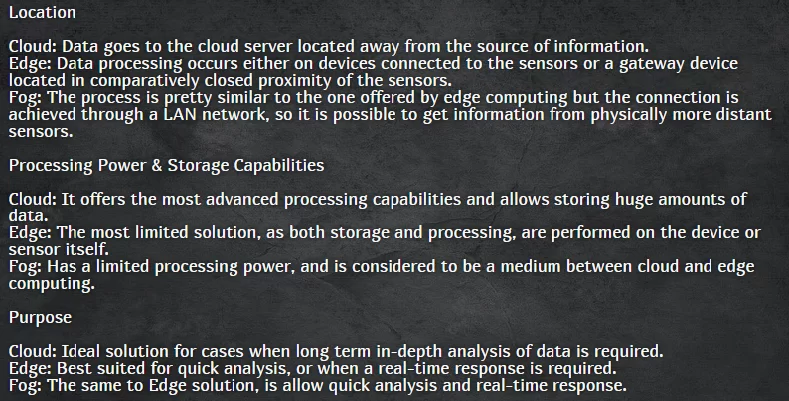With the development of technologies which resulted in the emergence of the Internet of Things, companies worldwide started implementing cloud computing solutions as an alternative to on-premise software. With information getting to a cloud, it became much easier for businesses who deal with customer data to collect, access, analyze, and further use it. Furthermore, cloud solutions allowed to store all the data received from crucial sources of information in one place, freeing businesses from headaches associated with spending money on memory storage capacity or on expending computing power.
But despite all the benefits cloud computing brings the technology is not standstill. The requirement for reduced downtime contributed to the emergence of new kinds of cloud computing that perfectly solve this problem. Today, these solutions are known as fog computing and edge computing.
This article aims at showing the main difference between cloud, fog, and edge computing, allowing you to answer the question on which one is better for your needs. But to start with, let’s disclose the reasons for the emergence of edge and fog computing.
Why Businesses Need Alternatives to Cloud Solutions?
Cloud solutions indeed help businesses in reducing the cost of data storage. Nevertheless, this does not mean that it costs nothing: the more you store, the higher is the price. That is why questions on whether it is necessary to store everything in the cloud and is there a way to separate and then select data that will go to the cloud storage appeared.
As soon as companies are receiving data from a range of sources, it became evident that some part of the data received is less useful, and could be stored at the edge of the network. In this way, its separation and selection could lead to significant savings. What is more, such approach could help companies to strengthen security issues.
As a response to these issues, edge and fog computing solutions were introduced. While sharing some similar features, these solutions also have some differences.
Pointing Out Differences
When comparing cloud solutions to fog and edge solutions, there are three major factors to consider. These are location, processing power & storage capabilities, and the purpose. Let’s dive into each to highlight the difference between these three options for data storage.

So When Choose Alternative to Cloud Computing?
Despite all the benefits cloud computing brings, fog and edge computing should be considered for the following reasons:
- Alternatives to cloud computing are more useful in cases when there is no 24×7 internet access because they can work without seamless connectivity to the internet.
- Because all the data is stored on the side of a user, fog and edge computing options provide better security options.
- Bi-directional communication of IoT device or application with a cloud is estimated in minutes, and that is why alternatives to cloud computing are more efficient as the communication with nodes takes just about a few milliseconds.
- Alternatives to cloud computing allow companies to reduce costs on cloud storage and offer the ability to separate information.
Edge and Fog Computing Potential in Different Industries
Although the alternatives to cloud computing are considered to be a comparatively new option for data storing and processing, three industries are already taking advantage of them. Below, we will disclose some of the existing and potential use cases of edge and cloud computing in different industries.
Industries Utilizing Fog and Edge Computing Solutions
In manufacturing, both edge and fog computing solutions are widespread even today. The survey conducted by the Automation World shows that manufacturers notice that alternatives to cloud computing allow them to reduce downtime (50%), to improve production output (38%) and profitability (37%), to decrease production costs (30%) and reduce waste (29%). The same survey showed that 43% of manufacturers have already deployed edge and fog solutions, and the number will continue to grow.
In retail, fog and edge computing are primarily used to improve customer experience, providing retailers with the ability to process, analyze, and take action on data: close to the source of the data generation — the customer.
In healthcare, edge computing opens up space for better drug tracking, improved energy management, personnel productivity through activity monitoring, inventory optimization and management, and 7 other cases defined by McKinsey & Co.
How Other Industries Can Benefit from Edge and Fog Computing?
In finance, edge and fog computing can significantly impact customer experience, making it more efficient and satisfying. For example, when used in relation to ATMs.
Fog and Edge computing in logistics can ensure the ability to get real-time data from various sensors, including street-based, package-based, and car-based.
In agriculture, alternatives to cloud computing can contribute to efficiency, productivity, and costs allowing to track both workers, equipment and livestock.
The Bottom Line
Companies now are looking for solutions that will provide maximum efficiency while reducing cost. When it comes to data storage and analytics, cloud solutions such as SaaS perfectly meet these needs. Nevertheless, the lack of decisive nature has spawned the ways for alternatives: fog and edge computing.
Even though today the implementation of these solutions is not easy, the need in collecting, separating and analyzing huge amounts of data coming from a variety of sources will make both fog and edge computing common to the most of companies.
At Elinext, we go step in step with the times, offering solutions that perfectly address data storage issues of our clients. Feel free to contact us with any questions, and thank you for reading.









